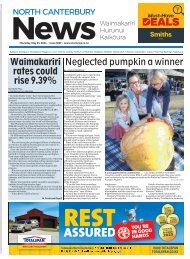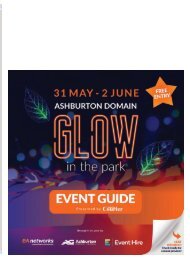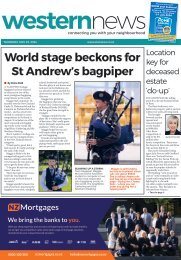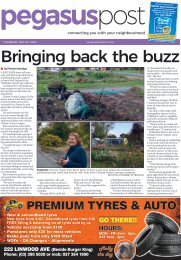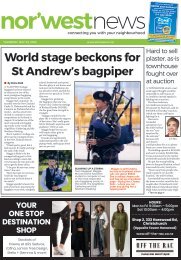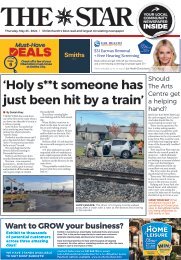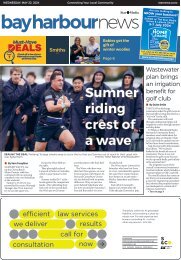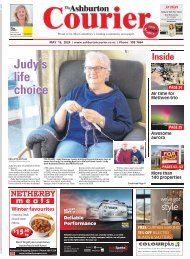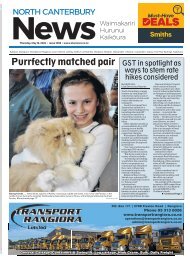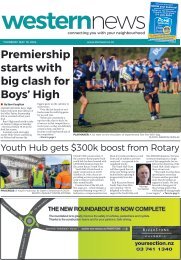You also want an ePaper? Increase the reach of your titles
YUMPU automatically turns print PDFs into web optimized ePapers that Google loves.
8 <strong>Ashburton</strong><br />
NEWS<br />
<strong>Courier</strong>, <strong>February</strong> <strong>22</strong>, <strong>2024</strong><br />
www.ashburtoncourier.co.nz<br />
Obituary: Small stature withabig heart<br />
Mid Canterbury lost alongserving and<br />
dedicated volunteer on January 14,<br />
when Jillian Annette Newton, died.<br />
The list of organisationsthe 74yearold<br />
gave her time to makes for<br />
impressive reading.<br />
Jill was born in <strong>Ashburton</strong> on May 7,<br />
1949. Apart from living 12 years in<br />
Alexandra, she spent the rest of her life<br />
in Mid Canterbury.<br />
She was twice recognised by the<br />
<strong>Ashburton</strong> District Council for her<br />
services to the community, with a<br />
district councilCommunity Civic Award<br />
in 2012 and the Mayor's Awardin2019.<br />
Since the early 1970s, Jill was an<br />
ostomate someone who has an opening<br />
in theirabdomen, changing the way<br />
waste exits the body.<br />
She spent alifetime volunteering<br />
while dealing with her own health<br />
problems. She had great empathy for<br />
people going through the ostomy<br />
journey and for people who struggled<br />
generally.<br />
Jill held various positions over ahalf<br />
century of involvement in ostomy<br />
associations in Mid Canterbury and<br />
furtherafield.<br />
This included chairingthe <strong>Ashburton</strong><br />
branch, aposition she had for almost 21<br />
years, following serving in the roles of<br />
secretary and treasurer.<br />
She was secretary of the South<br />
Canterbury branch for 16 years, vicepresident<br />
of the Asian and South Pacific<br />
Ostomy Association, anational<br />
executive member of the Federation of<br />
the NZ Ostomy Societies for 18 yearsand<br />
the organisations’s national president.<br />
Her national bodyduties included<br />
helping to organise regional and<br />
national meetings and conferences, as<br />
well as advocacy work.<br />
Her dedication to the ostomy societies<br />
led to her attending overseas<br />
conferences,including one in<br />
Frankfurt, Germany.<br />
At the time there was aterrorist<br />
threat, but that didn’t stop Jill goingout<br />
walking.<br />
Ostomates in nearly 25 countries<br />
received amagazine that Jill took on<br />
editing in 2003. It took her about 150<br />
hoursfor each of the magazines that<br />
were producedthree times ayear.<br />
The camps she ran for young<br />
ostomates from 11 to 20yearolds were<br />
PROFOUND IMPACT: Volunteer Jill<br />
Newton wastwice recognised by the<br />
<strong>Ashburton</strong> community for the service<br />
she gave.<br />
fun and helped those livingwith the<br />
condition make the mostoflife.<br />
Jill was amember of the New Zealand<br />
Red Cross.<br />
As well as being abranch member, Jill<br />
wentout with the eveningDistrict<br />
Nurses,providing an extra pair of hands<br />
and support for 34 years until the<br />
programme discontinueddue to Covid.<br />
In the aftermath of the <strong>February</strong> <strong>22</strong>,<br />
2011, Christchurch earthquake, Jill<br />
volunteeredwith Red Cross working in<br />
Christchurch. It wasn’tthe only<br />
earthquake she stepped up to help with.<br />
She respondedasaCivil Defence<br />
volunteeratthe Kaikōura earthquake.<br />
Jill volunteeredfor more than adecade<br />
with Civil Defence and was recognised<br />
last year with along service award.<br />
Her volunteering included work with<br />
St John and the New Zealand Police.<br />
She was avoluntary ambulance officer.<br />
If the police needed to interview a<br />
young person who didn’t have an adult<br />
with them, Jill was aperson they could<br />
call on to provide this support.<br />
Her love of swimming saw her<br />
volunteerasalife guard at the<br />
<strong>Ashburton</strong> community pool for more<br />
than 30 years.<br />
She describedherself as a‘‘night<br />
owl’’,soperfectly suited to arole with<br />
Community Patrols of New Zealand in<br />
<strong>Ashburton</strong> Town Watch.<br />
For more than 25 years,Jill assisted<br />
with the patrolling the streets of the<br />
district on weekendnights.<br />
She alsoprovide 10 years’ secretarial<br />
services. In 20<strong>22</strong> she received a<br />
commendation for 25 years of service.<br />
Her faith was an important part of<br />
who Jill was, and no doubt sustained her<br />
and gave her comfort through her many<br />
health battles and challenges. She was a<br />
member of the Salvation Army and<br />
worked as the corps office<br />
administrator.<br />
She had been an active participant<br />
when the Salvation Army provided an<br />
emergency caravan to respond to<br />
emergencies, helping the responders<br />
and those impacted by the event with<br />
refreshments.<br />
Alongside this, Jill did many things in<br />
the background to assist with the<br />
running of the church, from fillingin if<br />
the cleaner wasn’t there, to assisting<br />
with the community foodbank when<br />
needed.<br />
Other groups she gave her time to<br />
include as adriver for Presbyterian<br />
Support, member of the Kidney<br />
Foundation, board member of<br />
Neighbourhood Support, executive<br />
member with Victim Support and six<br />
years as support worker with the<br />
organisation, and volunteering at<br />
<strong>Ashburton</strong> community Christmas<br />
lunches.<br />
Jill was humble natured and very<br />
unassuming about her voluntary work.<br />
She refused to let the challenges of<br />
health obstacles stop her because she<br />
had azest for life.<br />
‘‘Life is for living and I’m living it,’’<br />
was afavourite saying of Jill’s and one<br />
she lived by.<br />
Jill is survived by son Gavin, daughter<br />
Jillian and their families.<br />
Dellwyn Moylan<br />
BOOST TO RANKS FOR MID CANTERBURY CHOIR<br />
Mid Canterbury Choir has had aboost to<br />
its ranks after holding open rehearsals.<br />
Manager Carol Gunn said the two open<br />
rehearsals, on each of the last two<br />
Monday nights, attracted 12 potential new<br />
members.<br />
Nine were keen to join. They<br />
represented agood mix of tenor, altos and<br />
sopranos.<br />
The number of active choir members<br />
was currently 37, ranging in age from<br />
about 20 to 75, so the new members could<br />
see numbers boosted to 46.<br />
‘‘Singing feeds our souls, we make new<br />
friends, learn new techniques and have a<br />
great time rehearsing and performing.<br />
The open rehearsals have allowed people<br />
to experience this over anight or two and<br />
the choir is excited about the new faces<br />
and voices joining us,’’ Gunn said. ‘‘Our<br />
uniform person will be busy sorting<br />
uniforms for them!<br />
‘‘Men are aprecious commodity for us<br />
but we have eight regular men, and one<br />
more from the newbies.’’<br />
Mid Canterbury Choir will have its first<br />
concert for the year on April 14 at 2pm at<br />
Baring Square Church. It will feature<br />
international organistMartin Setchell,<br />
who will be in <strong>Ashburton</strong> for the weekend<br />
to dedicate the church’s refurbished<br />
organ.<br />
Application<br />
closing dates<br />
Operationalcosts<br />
(programme or event)<br />
Up to $15,000<br />
<strong>22</strong>nd March<strong>2024</strong><br />
Major Grants Round<br />
Over $20,000<br />
(Phone to discuss priortoapplying)<br />
3rd May <strong>2024</strong><br />
Capital projects<br />
Up to $20,000<br />
26th July<strong>2024</strong><br />
Seeour websitefor further informationand to<br />
makeanonline application.<br />
www.comtrust.org.nz<br />
To discussany applications<br />
Phone: 03 687 7360 or 0800 672 287<br />
Email: crm@comtrust.org.nz<br />
2646013<br />
Researchers untangle faults<br />
BYJAMIE MORTON<br />
New Zealand Herald<br />
Researchers have untangledone of<br />
New Zealand’s most complex fault<br />
zones, in agroundbreaking study with<br />
potentialglobal implications for<br />
earthquake science.<br />
Their recentlypublished findings<br />
reconstruct thousands of years of<br />
activity in the Marlborough Fault<br />
System, which stretches acrossmuch<br />
of the northern South Island.<br />
It linked New Zealand’s two<br />
behemoth, bigrisk plate boundary<br />
systems –the AlpineFault and the<br />
Hikurangi Subduction Zone –while<br />
endlessly absorbing local pressure<br />
from “strikeslip” motion, where<br />
rocks at the boundary slipped past<br />
each other.<br />
Over millions of years,rocks within<br />
the system were being transferred<br />
from the Pacific plate to the<br />
Australianplate, as the boundary<br />
itself gradually shifted to the<br />
southeast.<br />
Runningparallel within it lay four<br />
major faults –Wairau, Awatere,<br />
Clarence and Hope –which have been<br />
active for tens of millions of years.<br />
While they’ve been involvedinbig<br />
events in the past –including a7.5<br />
event in 1848 that caused widespread<br />
damage –intriguingly, none were<br />
among the incredible 25 set off by the<br />
2016 massive Kaikoura Earthquake.<br />
Just why, remainedone of the<br />
biggest questions still facing<br />
The Marlborough Fault System <br />
linking the Alpine Fault and Hikurangi<br />
Subduction Zone stretches across<br />
much of the northern South Island.<br />
WIKIMEDIA COMMONS<br />
scientists –yet the new findings,<br />
publishedinthe journal Earth and<br />
Planetary Science Letters,have taken<br />
them much closer to understanding<br />
how the system works.<br />
Study author and GNS Science<br />
geologist Dr Russ Van Dissen said<br />
he and colleagues, from the<br />
University of Southern California<br />
and University of Sheffield, wanted<br />
to know whether the plate motion<br />
was always being accommodated in<br />
the same way across the system – or<br />
if it was being shouldered by<br />
individual faults within it, at<br />
different times.<br />
The answer lay within telltale<br />
signs of displacement in exposed<br />
river terrace surfaces.<br />
Contrarytolongheld<br />
assumptions, they discovered it had<br />
maintained asteady boundaryslip<br />
rate over the last 12,000 to 14,000<br />
years –allowing the entiresystem to<br />
“keep up” with hundreds of metres<br />
of plate movement.<br />
Moreinterestingly, they found the<br />
faults essentially worked together<br />
to take up this motion, with some<br />
slipping faster than others at<br />
different periods.<br />
“It’s like atradeoff: we might see<br />
one fault speeding up and another<br />
slowing down, but the rate of motion<br />
across the system stays the same,”<br />
Van Dissen said.<br />
The findings raised the need to<br />
consider fault systems as awhole –<br />
and could ultimately help change<br />
what scientists understand about<br />
similar ones overseas, in areas like<br />
SouthernCalifornia.<br />
“Of this type of study, Ithink this<br />
is the first and the best –and it’ll<br />
stay the best for awhile.”<br />
Beyond meregeological curiosity,<br />
the findings had implications for<br />
estimating the region’s earthquake<br />
risk.<br />
“By knowing there’s more<br />
individual variability between<br />
these faults, it can help us forecast<br />
the seismic hazard of the area more<br />
realistically.”




